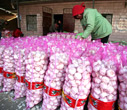Top Biz News
Deadly mine disaster another lesson for coal hungry China
(Xinhua)
Updated: 2009-11-25 17:30
When the fatal explosion occurred early Saturday in a coal pit in northeast China's Heilongjiang province, Chen Fugui was waiting for his two sons to come home and help him move into a new apartment.
Despite all the dangers he himself experienced in 31 years down the pit, it never occurred to Chen, 65, that his sons, aged 42 and 38, could die so tragically.
In one of the deadliest mine disasters in recent history, at least 104 people were killed at Xinxing Coal Mine under the State-owned Heilongjiang Longmei Mining Holding Group's subsidiary in the city of Hegang .
The toll may still climb as rescuers are still trying to reach the four miners who remain trapped, though their chances of survival are slim.
Eighteen families had agreed with mine authorities on a compensation scheme, which consists of 102,600 yuan ($15,024) in allowances for each dead miner's family, plus a compensation package of either a one-off 200,000 yuan payment, or a long-term scheme of 708 yuan a month for the spouse and 531 yuan a month for parents and children.
But money is little comfort for Chen, his handicapped wife, daughters-in-law and grandchildren, a boy and a girl.
What puzzles Chen and many other grief-stricken families is why the tragedy could have happened at Xinxing, a giant State-owned mine that is supposed to be trustworthy and well managed.
Three of the four major mine disasters reported this year have happened at State-owned mines.
Xinxing mine, where excavation began in 1917, was labeled as exemplary by the country's safety authorities this year for its "adequate safety measures."
The mine's management said they had a comprehensive digital system in operation, which tracked and located all miners underground to ensure people were evacuated in time of emergency.
However, no one could explain why so many lives were lost, despite the advanced system and all the safety rules.
Wang Chaojun, 50, and his 23-year-old son were among hundreds that survived the explosion. "We had meetings every day about safety regulations and all the dos and don'ts in the pit. I don't understand why it had happened."
Management failures
Though investigators from the State Administration of Work Safety (SAWS) are yet to pinpoint the cause of the accident, administration head Luo Lin has blamed mine authorities for failing to evacuate workers promptly after an extraordinarily high gas density was detected in the pit.
Fan Minghua, who monitors gas density in the pit, said his gas detector beeped at 1:37 am Saturday, a full hour before the explosion. He manually tested the gas density in the air, which read over 10 percent, and ordered everyone in sight to evacuate.
Safety regulations stipulate that all miners must be evacuated when gas density exceeds?two percent.
Fan did all he could to save lives. He stopped power, called coordinators on the surgace and told other gas monitors to evacuate miners.
He might not have even been the first to report the gas leak. A handwritten account of the accident, found at the emergency rescue headquarters Tuesday, said authorities received reports of the leak at 1:20 am, exactly 85 minutes before the explosion at 2:45 am.
At a press conference Monday, journalists demanded an explanation as to why management of the mine failed to evacuate more people. Mine official Zhang Jinguang, however, insisted evacuation was "timely."
He said the casualties were "inevitable" because evacuation took time and the miners had to run a long way from their mining platforms to the surface.
While investigators have yet to decide whether evacuation was timely, management failures and a fixation on output were apparently to blame for the accident.
Xinxing mine, as seen on the map, has more than 100 tunnels and 30 mining platforms, the deepest of which are 3,000 to 4,000 meters underground.
SAWS deputy chief Zhao Tiechui said Sunday he saw looming risks in the overcrowded mine with a complicated underground structure and poor ventilation.
The mine produces 1.45 million tons of coal annually and sends more than 3,000 miners down the pit daily. "Its underground structure, however, is far too complicated for its current ventilation system to work effectively. In times of emergency, it's difficult for the miners to escape through the long, zigzagging tunnels."
The SAWS said Saturday's accident started with a gas leak in one of the shafts. But as a result of poor ventilation, gas quickly poured into the main tunnel and triggered an explosion that shook 28 of all the 30 mining platforms in operation and damaged many buildings on the ground.
Painful lessons
Exactly four years ago, 171 people died in a similar disaster at Dongfeng Mine, another major colliery under Longmei Group. Despite a limited annual output of 500,000 tons, Dongfeng had three mining areas and 22 mining platforms.
"The company has apparently failed to learn the lesson: its mines are still overcrowded and are yet to improve efficiency," said professor Cheng Yuanping, a coal mine gas specialist with the Beijing-based China University of Mining and Technology.
China's ongoing overhaul to integrate coal resources and mining companies has mainly targeted small, privately-owned mines. Mines with annual output below 300,000 tons have been merged with larger mining firms, mainly State-owned companies.
"Such merging cannot guarantee an immediate improvement in safety standards," said Cai Changli, a mine safety specialist and member of the State Council's investigation team in Heilongjiang.
"Mine management cannot just stress output. They need to invest heavily to improve infrastructure and raise everyone's awareness of safety."













